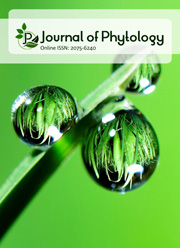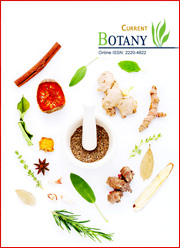Chemical composition of essential oil from the leaves of Cinnamomum camphora (L.) J. Presl
DOI:
https://doi.org/10.25081/jp.2024.v16.8796Keywords:
Cinnamomum camphora, Essential oil, Yield, Sensory characteristics, Chemical compositionAbstract
In the present study, the chemical composition of Cinnamomum camphora leaves collected from Algeria was studied. The chemical composition of the hydrodistilled essential oil of C. camphora, collected from Skikda (North Eastern Algeria), was analyzed by Gas Chromatography-Mass Spectrometry (GC-MS). The essential oil showed the presence of 17 major compounds representing 93.57% of total essential oil and the major compounds were camphor (36.81%), α-Pinene (9.91%), D-Limonene (8.63%) and Camphene (6.99%).
Downloads
References
Aminkhah, M., & Asgarpanah, J. (2017). GC-MS analysis of the essential oil from Artemisia aucheri Boiss. Fruits. Journal of the Chilean Chemical Society, 62(3), 3581-3582. https://doi.org/10.4067/s0717-97072017000303581
Bhandari, U., Kumar, A., Lohani, H., & Chauhan, N. (2022). Chemical composition of essential oil of camphor tree (Cinnamomum camphora) Leaves grown in Doon valley of Uttarakhand. Journal of Essential Oil Bearing Plants, 25(3), 548-554. https://doi.org/10.1080/0972060X.2022.2086828
Chen, H. P., Yang, K., You, C. X., Lei, N., Sun, R. Q., Geng, Z. F., Ma, P., Cai, Q., Du, S. S., & Deng, Z. W. (2014). Chemical constituents and insecticidal activities of the essential oil of Cinnamomum camphora leaves against Lasioderma serricorne. Journal of Chemistry, 2014, 963729. https://doi.org/10.1155/2014/963729
Chen, J., Tang, C., Zhang, R., Ye, S., Zhao, Z., Huang, Y., Xu, X., Lan, W., & Yang, D. (2020). Metabolomics analysis to evaluate the antibacterial activity of the essential oil from the leaves of Cinnamomum camphora (Linn.) Presl. Journal of Ethnopharmacology, 253, 112652. https://doi.org/10.1016/j.jep.2020.112652
Du, Y., Zhou, H., Yang, L., Jiang, L., Chen, D., Qiu, D., & Yang, Y. (2022). Advances in biosynthesis and pharmacological effects of Cinnamomum camphora (L.) Presl essential oil. Forests, 13(7), 1020. https://doi.org/10.3390/f13071020
Getachew, A. T., Holdt, S. L., Meyer, A. S., & Jacobsen, C. (2022). Effect of extraction temperature on pressurized liquid extraction of bioactive compounds from Fucus vesiculosus. Marine Drugs, 20(4), 263. https://doi.org/10.3390/md20040263
Guo, S., Geng, Z., Zhang, W., Liang, J., Wang, C., Deng, Z., & Du, S. (2016). The Chemical Composition of Essential Oils from Cinnamomum camphora and Their Insecticidal Activity against the Stored Product Pests. International Journal of Molecular Sciences, 17(11), 1836. https://doi.org/10.3390/ijms17111836
Lahlou, M. (2004). Essential oils and fragrance compounds: Bioactivity and mechanisms of action. Flavour and Fragrance Journal, 19(2), 159-165. https://doi.org/10.1002/ffj.1288
Lee, S.-H., Kim, D.-S., Park, S.-H., & Park, H. (2022). Phytochemistry and Applications of Cinnamomum camphora Essential Oils. Molecules, 27(9), 2695. https://doi.org/10.3390/molecules27092695
Mansard, M., Laurain-Mattar, D., & Couic-Marinier, F. (2019). Huile essentielle de Ravintsara. Actualités Pharmaceutiques, 58(585), 57-59. https://doi.org/10.1016/j.actpha.2019.02.012
Musso, L. (1926). La culture du Laurus camphora en Algérie. La Parfumerie moderne.
Poudel, D. K., Rokaya, A., Ojha, P. K., Timsina, S., Satyal, R., Dosoky, N. S., Satyal, P., & Setzer, W. N. (2021). The Chemical Profiling of Essential Oils from Different Tissues of Cinnamomum camphora L. and Their Antimicrobial Activities. Molecules, 26(17), 5132. https://doi.org/10.3390/molecules26175132
Rawat, A., Bhatt, D., Kholiya, S., Chauhan, A., Bawankule, D. U., Chanotiya, C. S., & Padalia, R. C. (2023). Comparative Chemical Composition and Acetylcholinesterase (AChE) Inhibitory Potential of Cinnamomum camphora and Cinnamomum tamala. Chemistry & Biodiversity, 20(8), e202300666. https://doi.org/10.1002/cbdv.202300666
Satyal, P., Paudel, P., Poudel, A., Dosoky, N. S., Pokharel, K. K., & Setzer, W. N. (2013). Bioactivities and compositional analyses of Cinnamomum essential oils from Nepal: C. camphora, C. tamala, and C. glaucescens. Natural Product Communications, 8(12), 1777-1784. https://doi.org/10.1177/1934578X1300801232
Xu, Y., Qin, J., Wang, P., Li, Q., Yu, S., Zhang, Y., & Wang, Y. (2020). Chemical composition and larvicidal activities of essential oil of Cinnamomum camphora (L.) leaf against Anopheles stephensi. Revista da Sociedade Brasileira de Medicina Tropical, 53, e20190211. https://doi.org/10.1590/0037-8682-0211-2019
Zhang, H., Huang, T., Liao, X., Zhou, Y., Chen, S., Chen, J., & Xiong, W. (2022). Extraction of camphor tree essential oil by steam distillation and supercritical CO2 extraction. Molecules, 27(17), 5385. https://doi.org/10.3390/molecules27175385
Zuccarini, P. (2009). Camphor: risks and benefits of a widely used natural product. Journal of Applied Sciences and Environmental Management, 13(2), 69-74. https://doi.org/10.4314/jasem.v13i2.55317
Published
How to Cite
Issue
Section
Copyright (c) 2024 Maroua Cheribot Cherif, Hicham Boughendjioua, Nora Sakhraoui

This work is licensed under a Creative Commons Attribution 4.0 International License.





 .
.